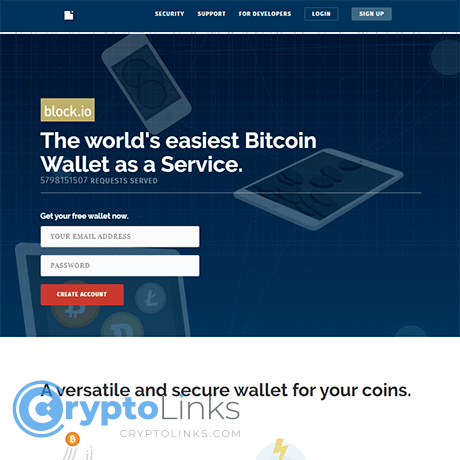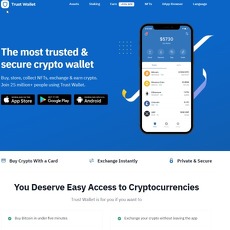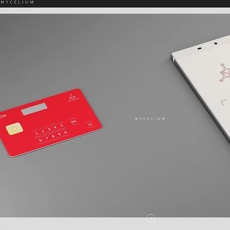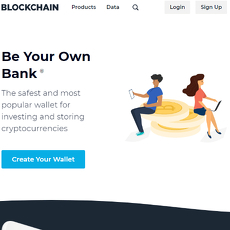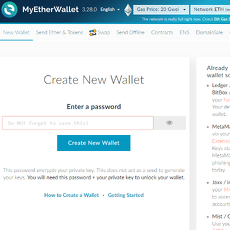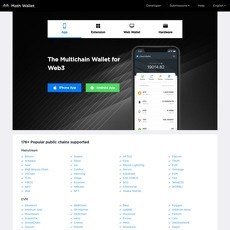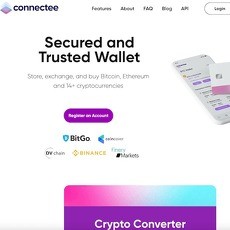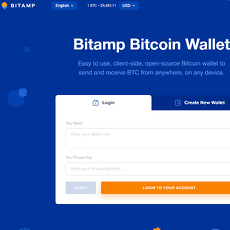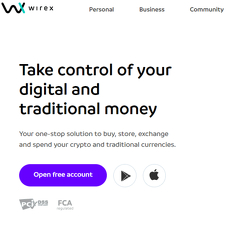Block.io Bitcoin Wallet Review
Block.io Bitcoin Wallet
www.block.io
Block.io Bitcoin Wallet Review Guide: Everything You Need to Know (with FAQ)
Have you ever sat in front of your computer, ready to send or receive Bitcoin, and suddenly thought: “What if I choose the wrong wallet and lose everything?” You’re not alone. The world of Bitcoin wallets can be a minefield for beginners and pros alike. I’ve seen countless people in crypto communities stressing out over which wallet to pick, and honestly, it’s no wonder.
The Problems (and Risks) of Choosing a Bitcoin Wallet
It’s easy to get swept up in the buzz of buying Bitcoin, but let’s get real—the wallet you use to hold your crypto matters just as much as the coins themselves. Why do so many people lose their money? It usually boils down to three main reasons:
- Getting hacked: Cybercriminals are lurking everywhere, and insecure wallets are prime targets. According to CipherTrace, hundreds of millions of dollars in crypto are stolen each year—often due to compromised wallets.
- Losing private keys: Your private key is basically your bank vault’s combination. If you lose it, you can wave your Bitcoin goodbye. A recent BBC report estimated that around 20% of all Bitcoin is likely lost forever, often because users misplaced their keys.
- Account blacklisting: Sometimes, wallets—or even entire blocks of wallet addresses—end up blacklisted. This can mean frozen or inaccessible funds, all because of poor wallet reputation or security vulnerabilities.
New users, especially, worry about everything: Is it safe to send funds? Did I copy the address correctly? How can I get my money out if I need it quickly? With crypto, one small mistake can be catastrophic.
What People Really Want from a Bitcoin Wallet (and What Goes Wrong)
If I had a dollar for every time someone told me, “I just want a wallet that works and won’t lose my Bitcoin,” I’d be writing this from my private Caribbean island. Jokes aside, here’s what everyone is really looking for:
- Easy withdrawals: No hidden hoops, weird waits, or random restrictions when you want your Bitcoin back.
- Simple access: You shouldn’t need a PhD in cryptography. Losing your password shouldn't mean losing your entire savings.
- No guessing games with fees: Ever been confused by mysterious transaction fees? You’re not alone.
- Privacy protection: Many people worry about nosy third parties tracking their every move or leaking personal data.
- Less complexity: With hardware, paper, mobile, desktop, and countless online wallets, decision fatigue is real. Which one is truly best for you?
Let’s not sugarcoat things. I’ve seen people get locked out for weeks after a failed password reset, miss out on a bull run because their wallet “maintenance” froze withdrawals, and get whacked with unexpected fees that ate into their profits. The struggle is real and it happens far more often than you’d think.
What’s at Stake: Your Money and Peace of Mind
Your crypto wallet does more than just hold coins. It holds your financial future. Here’s what you’re putting on the line by picking the wrong one:
- Permanent loss: Send Bitcoin to the wrong address or lose your keys, and there’s no “undo” button. The blockchain doesn’t forgive mistakes.
- Frozen funds: If your wallet provider gets blacklisted or targeted by regulators, you could wake up to an account you can’t use anymore.
- Unending stress: Worrying every time you hit “send” or double-checking your backup phrase shouldn’t be the norm. You deserve peace of mind, not constant paranoia.
A bad wallet turns what should be an empowering experience into a never-ending source of anxiety. And honestly, that’s the last thing anyone needs—especially in crypto, where the markets themselves are wild enough!
How Block.io Enters the Scene
Enter Block.io—a name you might have seen pop up in forums and reviews. What makes Block.io different is the promise to simplify the chaos. It’s not just another random wallet option. Block.io was designed to help people handle Bitcoin (and a few other coins) with less drama, less risk, and fewer headaches. Whether you’re scaling up or just getting your first taste of crypto, Block.io aims to make storage both safe and straightforward.
Curious to know how Block.io actually works, who should use it, and where it beats (or falls behind) the competition? I’ll break that all down next—so keep reading, because I’ll show you exactly what to expect and whether this wallet might finally be the answer you’ve been searching for...
Introducing Block.io: What Is It and Who Should Use It?
Ever wish there was a wallet that didn’t make you feel like you were taking a leap of faith every time you sent or received Bitcoin? That’s exactly the itch Block.io is trying to scratch. Started back in 2014, Block.io isn’t some flashy new wallet on the block—it’s a pretty solid player with years of experience, quietly building a reputation for being both safe and pretty friendly to new users.
Block.io sets itself apart by focusing on making cryptocurrency storage simple without caving on security. It’s got support not only for Bitcoin but also for Litecoin and Dogecoin. That might sound like just another item on a feature checklist, but for many people tired of downloading a different wallet for every coin, this kind of “all-in-one” approach feels like a breath of fresh air.
I once read, “Simplicity is the ultimate sophistication.” With crypto, that couldn’t be truer. Things can get complicated—fast. But Block.io’s interface feels surprisingly welcoming, whether you’re dipping your toes in for the first time or you’ve been around the block a few times.
Quick Overview: What You Can (and Can’t) Do With Block.io
Let’s paint a clear picture. What are you actually getting when you sign up for Block.io? Here’s what stands out:
- Multi-currency support: One wallet for Bitcoin, Litecoin, and Dogecoin—save the app space!
- Multi-signature security: You can set up wallets that require two or more people to approve transactions. It’s a big plus if you work in teams or just want extra security.
- Web wallet & API: Easy-to-navigate on any browser, and if you’re a developer or a business owner, you get full access via API to automate payments or track multiple accounts.
- No need for browser extensions: Forget fumbling with unnecessary installs. Login is smooth and works across devices.
Here’s what Block.io doesn’t do:
- It’s not a hardware wallet—your keys don’t live on a physical device.
- No built-in exchange—Block.io is about storage and transactions, not buying/selling.
Who Is Block.io For?
This is where Block.io really shines—it doesn’t try to be everyone’s everything, but it hits the sweet spot for quite a few types of crypto users:
- Beginners: If you’re new and just want to store and use Bitcoin without the fear of being overwhelmed, Block.io keeps things simple.
- Developers: Those needing reliable APIs to automate transactions or run crypto businesses.
- People who need speed and convenience: No long downloads, quick setup, works on any web browser.
- Anyone handling group funds: Thanks to multi-signature wallets, teams, families, clubs, and organizations can require multiple approvals for transactions, which massively reduces the risk of one person running away with the funds.
I’ve seen plenty of wallet horror stories. One reader reached out last year after losing access to their coins on a wallet app that crashed during an update. Block.io’s online approach and backup features leave a lot less room for that kind of one-way ticket to disaster.
How Block.io Is Different from “Traditional” Wallets
Now, let’s talk comparisons—because even a quick Google search pulls up a sea of options: hardware wallets, mobile apps, even those infamous paper wallets people used to swear by. So, where does Block.io fit in?
- Vs. hardware wallets: Hardware wallets keep your crypto offline—which is undeniably the safest route if you’re planning to sit on your Bitcoin for years. But, they can cost $60+ and are pretty unfriendly if you lose the device or forget a PIN. Block.io, being web-based, means instant access from anywhere, no matter what gadget you’re using—just remember your credentials.
- Vs. mobile wallets: Many mobile wallets are handy, but lose your phone and you could be in for some major stress. Block.io isn’t tied to your device, so your funds aren’t gone just because your phone is.
- Vs. paper wallets: Sure, paper wallets avoid hacking altogether, but let’s be real—one spilled coffee or lost slip of paper, and it’s game over. Block.io gives you the safety of online backups without the clumsiness of physical storage.
Sometimes, the challenge is about finding something that “just works” without needing an instruction manual or a degree in Computer Science. Block.io tries to bridge that gap—offering cloud-level access with forward-thinking security.
“In crypto, you don’t get a second chance if things go wrong. The right wallet is your armor.”
Wondering how to actually get started? Or maybe you’re itching to know what it’s really like to log in, set up your wallet, and try your first Bitcoin transaction without any hair-pulling? Stick around, because in the next section I’ll walk you through exactly how to kick things off with Block.io—step by step. Ready to see how easy it can be?
Getting Started: Setting Up and Using Block.io
There’s that moment—when you’re ready to finally move your Bitcoin into a wallet you control—that can feel a bit intimidating. Will you mess something up? Is this the “right” kind of wallet for your needs? Let me walk you through Block.io, so you can see firsthand how surprisingly simple it is to get started (and avoid all those rookie mistakes that make your stomach churn).
How to Create Your Block.io Wallet (Step-by-Step)
First things first, let’s get your wallet set up. Here’s how it usually goes:
- Head to the Official Site: Open your browser and go to Block.io. No need to install extra software or worry about mobile compatibility right now.
- Tap “Sign Up”: Enter your email, set a strong password, and confirm. Pro tip: Use a password manager here—you’ll thank yourself later!
- Create Your PIN & Private Key Backup: Block.io immediately prompts you to back up your secret PIN and private key. This is your lifeline if you ever lose access. I once heard from a reader who skipped this step and, well, let’s just say it ended with a lot of regret and no happy ending. Treat your backup like gold!
- Log In Securely: After registering, log in using your credentials. Block.io will often ask for your PIN on sensitive actions—it’s an extra line of defense, not just busywork.
“The secret of getting ahead is getting started.” — Mark Twain. In crypto, those who prepare don’t have to panic when things go sideways.
How to Receive Bitcoin: Your Wallet Address
Receiving Bitcoin with Block.io really couldn’t be easier (or safer). Here’s the play-by-play:
- Get a Fresh Address: Inside your dashboard, each coin you add comes with a ‘Receive’ or ‘Deposit’ option. Click it, and Block.io will generate a new Bitcoin address just for you.
- Share Safely: This is the public address you can copy and send to your employer, friend, or whoever is paying you in Bitcoin. Only share this – never your private key. I can’t stress this enough! I’ve seen too many good people lose funds by mixing up which part they’re supposed to keep secret.
- Double-Check: Before sharing, check every digit. QR codes can help—less risk of typos!
A survey run by Kaspersky in 2022 found that over 20% of crypto users sent funds to the wrong address at least once. You don’t have to be one of those stats—slow down and verify.
How to Send and Withdraw Bitcoin from Block.io
Ready to spend or withdraw your BTC? Here’s what you need to know:
- Initiate the Send: Hit the ‘Send’ button. Enter your recipient’s Bitcoin address (triple-check this—there are no “undo” buttons in crypto).
- Set the Amount: Choose how much Bitcoin you want to send. You’ll see estimated fees too, so you’re not left guessing.
- Confirm Security Checks: You’ll be asked for your PIN, and sometimes get an email or app-based confirmation. Frustrating? Maybe—but it’s your Bitcoin at stake, not just a social media login.
- Review & Send: Always read over everything before hitting “Send.” Transactions on the blockchain are forever.
Block.io’s withdrawal times and fees are honestly pretty competitive, but remember: blockchain confirmation is never instant. Smaller and medium transactions typically show up within 10–30 minutes, but if the network is busy, patience is key. Nobody loves waiting, but at least you can track progress in real-time.
Making the Most of Block.io’s API (for Developers)
Here’s where Block.io gets fun for the techies and businesses. If you ever wished you could automate payouts, integrate wallet functions into a custom app, or whip up your own payment processor, their API documentation is shockingly friendly. Some wallet services offer an API but require a PhD to use it. Block.io keeps it simple—JSON responses, thorough guides, and examples you can copy-paste and run with.
- Automate Bitcoin, Litecoin, and Dogecoin operations with just a few lines of code.
- Set up multi-user or business wallets (think payroll, payouts, tipping bots, and more).
- Customize security levels and get notifications in real-time when money moves.
If you’re non-technical, feel free to skip this bit—but if you love tinkering, it’s a playground for creative crypto use cases.
Getting set up with Block.io? Honestly, it’s about as painless as it gets in the crypto industry. But remember, none of these steps matter if your wallet isn’t safe to begin with. Next, I’m going to pull back the curtain on Block.io’s security—how does it really hold up? Can your funds be blacklisted or locked? I’m getting into the details just ahead, and you’ll want to stick around for some security truths nobody talks about…
All About Security: How Safe Is Block.io Really?
Security is the dealbreaker for any Bitcoin wallet. If you’re like most people, you’re not just storing coins—you’re putting your trust in a service to keep real money off-limits to hackers, scammers, and bad luck. So, how does Block.io handle its end of the bargain?
There’s a powerful quote I always remember when reviewing wallet security:
“Security isn’t just a feature—it’s the foundation. Lose trust, and you lose everything.”
That’s the bottom line. Let’s see how Block.io stacks up…
Understanding Multi-signature: What It Means for You
Block.io is known for going beyond bare minimums. It uses multi-signature (multi-sig) protection—a security approach that’s way tougher than just hiding your coins behind a single password. In plain English, multi-sig means you need more than one key to unlock the wallet. Imagine a vault that needs two (or even three) people to turn their keys at once. That’s what’s happening here.
- Multi-sig 2-of-3: Most Block.io wallets use a 2-of-3 setup. Two keys out of three are needed for any transaction—usually, one stays with you, another with Block.io, and a backup with a trusted third party or device.
- Why is this cool? It keeps a hacker from taking your Bitcoin even if they hack your account. They’d need extra keys, which are probably sitting safely offline.
- Real World Proof: Studies have shown that multi-signature setups significantly reduce loss from hacks. Some major wallet breaches on simpler platforms could have been stopped cold if multi-sig was in play.
For most people, this is a game-changer. You don’t have to be a crypto expert; Block.io takes care of the complex stuff, and your funds have an extra safety layer automatically.
What Happens If You Lose Access to Your Wallet?
The panic is real: “What if I lose my password? Or my recovery info?” With Block.io, there’s a clear path back—if, and only if, you do your part from the start.
- Backups: During setup, you’re prompted to save a recovery phrase. This isn’t optional. It’s your golden ticket if you get locked out.
- Password resets: If you forget your normal password but have that backup phrase, you can reset things. No backup, no luck. That’s the trade-off for top-level safety.
- Multi-sig rescue: Since your wallet needs more than one “key,” an attacker (or even Block.io itself) can’t take your coins without you. But if you lose your backup, nobody can save your wallet, not even Block.io. It puts the power—and the responsibility—in your hands.
Think of it like this: as long as you treat your recovery phrase like gold (write it down, hide it in a safe), you’ve got a firewall against most disasters.
Can Block.io Wallets Be Blacklisted?
This is a tricky issue. Online wallets, even secure ones, can sometimes see the addresses they create get flagged or blacklisted in big public databases. Did you buy from, or send coins to, someone with a “tainted” wallet? Your address could potentially end up associated with those blacklists.
- Some users have reported that exchanges or certain services might freeze or delay coins coming from Block.io addresses that have been flagged elsewhere.
- This is a challenge for almost every hot wallet, and Block.io is no exception.
- To protect yourself: check your addresses using services like Blockchain.com Explorer and avoid mixing coins with strangers.
It’s a trade-off. You get the convenience of an easy-to-use wallet, but there’s always a slim chance that an address could get caught in the crossfire. I always recommend staying up to date on best security habits and checking incoming funds, especially if it’s a large amount.
Are There Any Security Shortcomings?
Nothing online is bulletproof. Block.io does an impressive job with security, but here’s what you need to keep in mind:
- It’s an online wallet. No matter how many safety features, being online means a smart attacker could target your device, your password, or your network.
- Phishing and fake sites. Hackers love to make lookalike sites. Always double-check the URL before logging in. Bookmark the real site.
- Your habits matter. Use strong, unique passwords and enable 2FA (two-factor authentication). Most breaches happen because someone got lazy with their password, or a phone with 2FA was compromised.
- For big savings? If you’re looking to store a life-changing amount of Bitcoin, a hardware wallet may be the smarter choice. But for everyday spending, business use, or developers building with APIs, Block.io strikes a good balance between speed and security.
I get asked all the time: “Is any wallet 100% safe?” The honest answer is no, but Block.io gets you a lot closer to peace of mind—if you do your part and think before you click.
Ever wondered how this plays out in real daily use, or what actual users say when things go sideways? The real test is in the trenches. Curious about what it’s like to use Block.io every day—and how it compares side-by-side with other top wallets? Let’s keep going. You’ll want to see some real examples (and surprises) coming up next.
Block.io in Real-World Use: The Good, The Bad, and The FAQs
What’s It Like Using Block.io Every Day?
If you’re anything like me, you judge a wallet not just on promises but on what it’s like in the real world—stress, rush, late-night transactions, and the odd panicky moment when you triple-check you’re not pasting the wrong address.
Let’s talk plain English: Block.io’s web interface is a breath of fresh air if you’re coming from clunkier wallets. The dashboard is clear—your balances, recent transactions, address book, and quick-access to sending and receiving coins. No weird hidden menus or surprise pop-ups. I've heard from users who manage business payouts or need to make regular withdrawals—one even told me they processed dozens of payouts a day and didn't have to touch the API thanks to the simple multi-send feature.
Speed is solid. Standard transactions reach the blockchain as quickly as you'd expect for Bitcoin, though keep in mind, network congestion is always a general variable. For in-wallet transfers between Block.io users, things are almost instant, and that’s a bonus for folks who operate mostly within that ecosystem.
Where Block.io really shines is in its multi-sig approach: even a family member who's only kind-of-techie was able to set up a joint wallet with me in under ten minutes, and they called it "the least stressful crypto thing I've ever done." That’s not something I hear about many wallets.
The flip side? Because it’s an online wallet, you’re putting trust in Block.io’s uptime. There have been rare reports of temporary API slowdowns or maintenance windows, which, although addressed quickly, are a reminder that no always-online solution is perfect. From what I’ve seen, Block.io updates their security and features regularly—this matches what I consider crucial for any wallet on our best-of lists.
Frequently Asked Questions About Block.io
- How do I withdraw Bitcoin using Block.io?
Click “Send,” paste or select your recipient’s address, enter the amount, review fees (displayed transparently), and complete multi-sig approval if set. Funds are sent once the transaction broadcasts to the network. Always double-check every detail—it’s not like sending a text! - Can Block.io wallets be blacklisted?
It is possible, as with any wallet, if your address ends up involved in flagged transactions. Block.io does not prevent you from accessing your funds, but exchanges and services may restrict transactions from blacklisted addresses. Always use wallets responsibly and keep addresses private. - What if I lose my private key?
If you lose access to your private key or backup phrase, you’re locked out—no central recovery possible. The only way back is with your backup. I strongly suggest storing backups offline, in at least two places. Paranoia is a virtue here. - How do I get paid in Bitcoin with my Block.io wallet?
Just generate a new receiving address via your dashboard and share it. You can create as many addresses as you want for privacy or accounting, all routed to your wallet’s main balance. - What are the costs and fees?
Block.io charges a small service fee for sending transactions, and of course, you’ll pay standard Bitcoin network fees, which are shown before you confirm. There are no fees for receiving, holding, or creating new addresses.
Block.io Versus Other Popular Wallets
| Feature | Block.io | Electrum | Ledger Nano S/X |
|---|---|---|---|
| Type | Web & API | Desktop/Mobile | Hardware (Offline) |
| Multi-signature | ✓ Yes | ✓ Yes | ✗ No |
| Supported Coins | BTC, LTC, DOGE | BTC, some support for others via plugins | BTC, ETH, +1000 others |
| Accessibility | Instant, browser/API | Requires software install | Needs physical device |
| Best Use | Quick access, automation | Desktop power users | Long-term, high-value storage |
Use Block.io when you want a blend of web convenience, multi-sig, and decent API support—perfect for small teams, developers, or folks who just want “it works” simplicity. But if you’re moving life-changing sums, nothing beats hardware for peace of mind (as much as that can ever be true in crypto). That's why you should keep reviewing your options, and don't forget to check my detailed wallet comparisons to match your plan.
How Does Cryptocurrency Wallet Choice Fit into Your Bigger Crypto Plan?
Choosing a wallet isn't just about today’s transaction—it’s a pillar of your entire crypto journey. Whether you’re stacking sats, running a business, or experimenting with code, your wallet choice impacts security, daily stress, and even tax prep.
I've spent years digging into wallet pros, cons, security, and feature sets for all types. If you’re feeling that wallet overwhelm, you’re not alone.
Ready to figure out whether Block.io—or something else—deserves your trust? Up next, I’ll show you the big picture and reveal who Block.io is really best for, plus the smartest next steps to lock down your coins. Would you risk your Bitcoin on an online wallet, or is hardware your style? Let’s get honest in the final part…
Final Thoughts and Next Steps
Alright, we’ve come a long way together exploring what Block.io can actually do for you in the wild world of crypto. By now, you should have a real sense of the strengths and quirks this wallet brings to the table. But crypto isn’t about picking the first thing that works—it’s about making sure your choice fits you, your goals, and your way of staying safe.
So, Is Block.io the Best Bitcoin Wallet for You?
If you want a wallet that’s beginner-friendly, supports multiple coins, lets you automate things with an API, and prioritizes security with multi-signature technology, Block.io is a pretty solid choice. Its web-based access is perfect if you’re juggling a few devices, or if you’re a developer itching to connect wallet actions with other projects.
On the other hand, if you’re hardcore about privacy—think you’ll sleep better with your keys on a hardware wallet, completely offline—Block.io might not tick every box. I’ve found that some users, especially those nervous about cloud-based solutions, still favor old-school hardware wallets or mobile solutions that never touch the web.
Every wallet comes with trade-offs. For business owners or anyone who needs automatic transaction handling, Block.io’s API and multi-sig stand out. Just remember, no technology solves everything if you let your guard down or lose your private key backup. Bottom line: The best wallet is the one that matches your needs and your comfort level when it comes to risk.
More Crypto Wallet Resources
Still on the fence or feeling like you want to check out more wallets before making your move? You're not alone. Even after reviewing dozens of crypto wallets over the years, I still learn new things every week. Technology moves fast, and so do hackers—so staying updated is half the battle.
I’ve put together an always-fresh list of the top wallets—rated for security, transparency, fees, and usability—over at this resource on Cryptolinks.com. If you’re hunting for alternatives, or just want to sharpen your scam radar, I strongly recommend checking out that list. You’ll find gems for every type of user, from total rookies to pros running a business from their phone.
Keep Your Bitcoin Safe—Stay Smart and Informed
There’s no big secret to keeping your crypto safe: research, use some common sense, and never get too comfortable. Wallets like Block.io can make things way easier, but you should always make secure backups, use two-factor authentication, and, above all, never reveal recovery phrases to anyone.
If you ever get stuck, confused, or just want to share an experience—leave a comment below or send a message. I’ve seen far too many people make panicked mistakes when a quick question could have saved everything. Crypto doesn’t need to be a solo journey. Let’s keep the community informed and secure, one wallet at a time.

